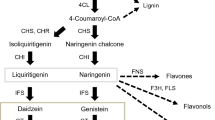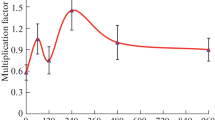Abstract
The dependence of the frequency of recessive lethal (two groups), chlorophyll and morphological mutations on the mutagen concentration was determined in M2 after subjection to N-nitroso-N-methylurea applied to seeds ofArabidopsis in three concentrations (0·05, 0·10 and 0·20mm). The observed frequencies were compared with the theoretically expected ones for the linear and for two exponential types of dependence, by using the t-test, according to the formulas m=k. C, m=k. C3/2, m=k. C2. No satisfactory agreement with any expected type of dependence was found when directly observed frequencies were used. Since a considerable deficit of mutation frequency was observed in high concentrations, the correction of frequency values was done with respect to the probability of occurence of double mutations. After such a correction, a clear exponential relation was found in both types of lethals and a linear one in chlorophyll and morphological mutations. The probable occurence of multiple mutations should be, therefore, taken into account if the dependence of mutation frequency on the concentration of mutagen is discussed.
Abstract
Byla sledována závislost frekvence recesivních letálních mutací dvou typů a mutací chlorofylových a morfologických v M2 u Arabidopsis rasy Dijon, po působení mutagenu aplikovaného na semena ve třech koncentracích (0·05, 0·10, 0·20mm). Pozorované frekvence byly pomocí t-testu srovnávány s teoreticky očekávanými pro závislost lineární a dva typy závislosti exponenciální podle vzorců m=k. C, m=k. C3/2, m=k. C2. U pozorovaných frekvencí nebyla zjištěna uspokojivá shoda se žádným z očekávaných typů závislosti. Poněvadž při vysokých koncentracích byl pozorován značný deficit frekvence mutací, byly jednotlivé hodnoty frekvencí korigovány s ohledem k pravděpodobnému výskytu dvojitých mutací. Po této korekci byla u obou typů letálních mutací zřejmý exponenciální vztah, kdežto u chlorofylových a morfologických mutací vztah lineární. Proto by měl být při rozboru závislostí mezi koncentrací mutagenů a frekvencí mutací brán zřetel na pravděpodobnost vzniku vícenásobných mutací.
Similar content being viewed by others
References
Brock, R. D.: Response ofTrifolium subterraneum to X-rays and thermal neutrons.—Rad. Bot.5: 543–555, 1965.
Brock, R. D., Andrew, W. D.: X-ray induced variation inMedicago polymorpha var.vulgaris.— Aust. J. biol. Sci.18: 1119–28, 1965.
Cetl, I.: Über die Korrektion der Mutationshäufigkeit nach der Wahrscheinlichkeit des Auftretens von Doppelmutationen.—Report on Colloquium about mutation genetics and reparations of mutations, University Brno, 15. 6. 1967.
Dubinin, N. P.: Problemy radiocionnoj genetiki. [The Problems of Radiation Geneties.]—Gosatomizdat, Moskva, 1961.
Dubinin, N. P.: Molekuljarnaja genetika i dějstvije izlučenij na nasledstvěnnost. [Molecular Genetics and the Effect of Radiation on Heredity.]—Gosatomizdat, Moskva, 1963.
Gaul, H.: Mutationen in der Pflanzenzüchtung.—Z. Pflanzenz.30: 194–307, 1963.
Gichner, T.: The mutagenic activity of Nitrosoamides with methyl and ethyl groups.—Rep. Int. Symp. Göttingen pp. 200–206, 1965.
Hänzel, H.: Model dlja približennogo opredělenija teoretičeski ožidajemych veličin optimal’nych častot mutacij, prichodjaščichsja na odno jadro v pokolenii M1 (s točki zrenija otbora chozjajstvenno cennych mutacij v različnych pokolenijach. [Model for a theoretical estimate of optimal mutation rates per M1-nucleus with a view to selecting beneficial mutations in different M-generations.]—Genetika9: 49–57, 1967.
Muller, H. J.: The mauner of production of mutations by radiation.—In:Hollaender, A. (ed.): Radiation Biology vol. 1, pp. 475–625. McGraw Hill Book Co., N. York 1954.
Muller, H. J.: Advances in radiation mutagenesis through studies onDrosophila.—Peaceful uses of atomic energy: Proc. United Int. Conf., Geneva vol. 22: Biological effect of radiation, pp. 313–321, 1958.
Müller, A. J.: Embryonentest zum Nachweis rezessiven Letalfaktoren beiArabidopsis thaliana. Biol. Zentralb.82: 133–163, 1963.
Müller, A. J.: Mutationsauslösung durch Nitrosomethylharnstoff beiArabidopsis.—Züchter: 102–120, 1964.
Müller, A. J.: Die Induktion von rezessiven Letalmutationen durch Äthylmethansulfonat beiArabidopsis. I. Dosis-Effekt-Beziehungen und deren Beeinflussung durch die Behandlungsbedingungen. —Züchter: 201–211, 1966.
Valencia, J. I.: A cytogenetic analysis of lethals induced by a low and by a high dose of X-rays inDrosophila melanogaster.—Proc. Int. Congr. Genet., 9th Congr., pp. 895–896, 1954.
Veen van der, J. H.: Linear response for induced lethals, including maternally conditioned embryonic lethals.—Arabid. Inf. Serv.5: 49–50, 1968.
Weber, Erna: Grundriss der biologischen Statistik.—G. Fischer Ver., Jena, 1956.
Author information
Authors and Affiliations
Additional information
Address: Brno, Kotlářská 2, Czechoslovakia.
Rights and permissions
About this article
Cite this article
Riesová-Kučerová, M. The dependence of the frequency of recessive lethal and vital mutations inArabidopsis thaliana (L.)Heynh. on the concentration of N-nitroso-N-methylurea. Biol Plant 11, 338–346 (1969). https://doi.org/10.1007/BF02921398
Received:
Issue Date:
DOI: https://doi.org/10.1007/BF02921398




